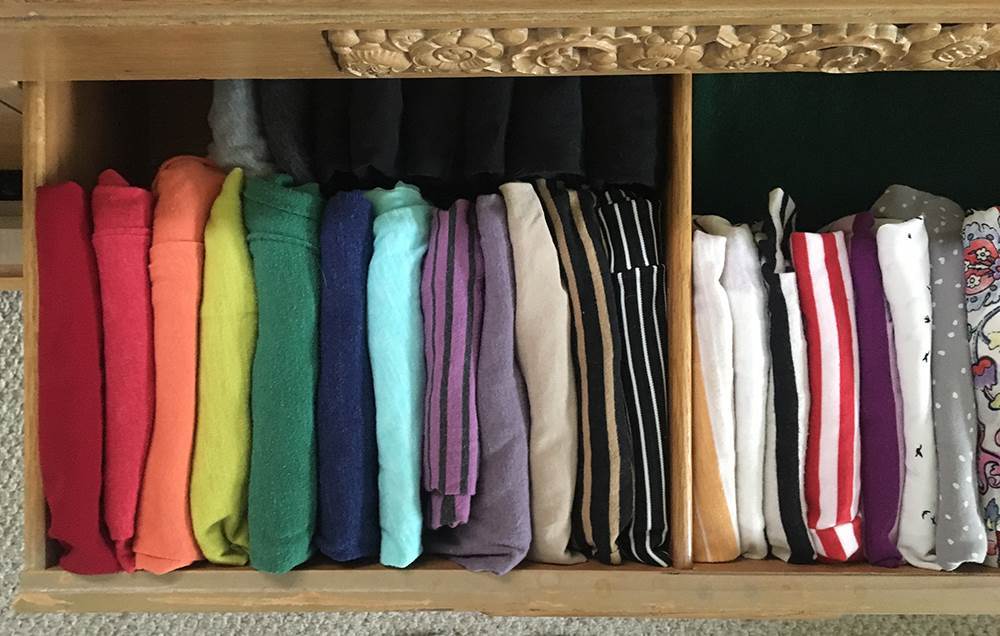The easy yet innovative technique is a true life-changer.
About two years ago, I overheard some coworkers gushing about a book that helped them finally get rid of a bunch of stuff they no longer needed. The palm-sized manual by Japanese organising expert Marie Kondo vows to help readers declutter their homes once, very thoroughly, and then never have to do it ever again. That appealing promise turned the book into a longstanding New York Times bestseller—and inspired me to pick up a copy of my own to see what the fuss was about.
In short, Kondo encourages you to assess every single item you own to determine whether or not it “sparks joy.” If it doesn’t, she says you should get rid of it. Her decluttering process, called the KonMari Method, requires you to sort everything by category rather than by room, which means your home will get a LOT messier before it actually gets tidy.
I have a confession: I didn’t have the motivation to work the full KonMari magic in my apartment. I started, and then the sorting piles that accumulated in my bedroom drove me nuts, so I stashed everything back away as neatly as I knew how. But the one lesson from the book that stuck—and that I intend to use forever—is Kondo’s technique for folding and storing clothes. I won’t go into excruciating detail about exactly how to fold each type of clothing this way (watch the video below for that), but the gist is this: You fold each article so that it can stand up in a row with other clothing items like it. This way, you see all of your shirts, socks, pants, and other wearables like books on a shelf.
See how to fold clothes the KonMari way:
“This method enables us to see what we have at a glance without having to move any clothing items out of the way,” says Lisa Mark, a certified professional organiser. “Of course the effectiveness of this method also assumes that there is no overflow and that our storage space is big enough to accommodate what we have.” Though Kondo's book turned this technique into a phenomenon, Mark points out that many people (including herself) have always stored their clothes this way. She also notes that there’s no one-size-fits-all folding method, so this technique won’t help everyone declutter their wardrobes.
“Although I really like this folding method, whether or not I use this method with my clients depends on whether a client is willing and able to take the extra time needed to learn to maintain the system,” Mark says. “I figure that as long as the clothing lands in the drawer or on the shelf, it is an improvement over having it in piles on the floor regardless of what method is used to fold it.” Certain life obstacles make it challenging to keep the system up, Mark points out, like if you just moved, had a new baby, or are suffering from a serious illness.
For me, the KonMari folding method was simple to work into my routine. Sure, it took some getting used to at first, but I soon learned that the benefits far outweighed the extra time spent folding. Here are five ways the method has streamlined my life:
Packing my suitcase is so much simpler.
To be fair, I've always been a light packer, but the process has become total cake since I've changed how I fold clothes. Just like in a drawer, tidy vertical rows in a suitcase maximise space and keep items from getting badly creased during travel. I can actually take more outfit options than I used to be able to fit in there, which is perfect when I don't know how dressed up or down each night of vacation will be.




Fitting clothes into my dresser is no longer a struggle.
By far the biggest advantage of this vertical folding hack is the space it frees up. When I first tried it, I was amazed to see empty rows in drawers that I once had to cram T-shirts into—and that was without getting rid of any clothes! Of course, this doesn't mean you should fill in with brand-new items that you don't need, but it's a good opportunity for storing foldable clothes that are monopolising precious closet space.
The other beautiful thing about neatly folding and standing clothes like this rather than stuffing them into my wardrobe: fewer creases. I can't count how many times I used to rewash shirts just because they had been wrinkled into a ball in the back of my dresser and I didn't feel like ironing them. And who wants to do extra laundry? Not only that, but fresh-looking tops keep me looking more polished in the workplace.
I take way less time to get ready in the morning.
You'd be shocked how a teensy bit more time spent folding can shave minutes off your morning routine. Because I can clearly see all of my clean clothing options in my dresser, I don't have to search through stacks to find what I want to wear. This makes it far simpler to pull together outfits in a hurry. It also makes it easier for me to pack my gym bag in a pinch or get my butt out the door for a morning run, since I can more quickly grab athletic socks, leggings and tops when I haven't laid them out the night before. And you can clean up your wardrobe to get motivated, too: Studies show that people make healthier choices (like working out or eating right) when their homes are organised.It’s easier to part with unworn clothing.
I used to do spring clean-outs of my clothing but still hoard items I hadn't worn in ages because they had sentimental value or I felt like I needed to get my money's worth out of an impulse buy that wasn't really my style. Even when following the KonMari "spark joy" method, I struggled to narrow things down. (Hey, that dress did spark joy that one time I wore it on New Year's Eve!) But once I consistently used the vertical folding technique, it became clear which clothes belonged in the donation box. I could see the unworn pieces standing right up in my dresser drawers, just taking up space. Problem solved.









